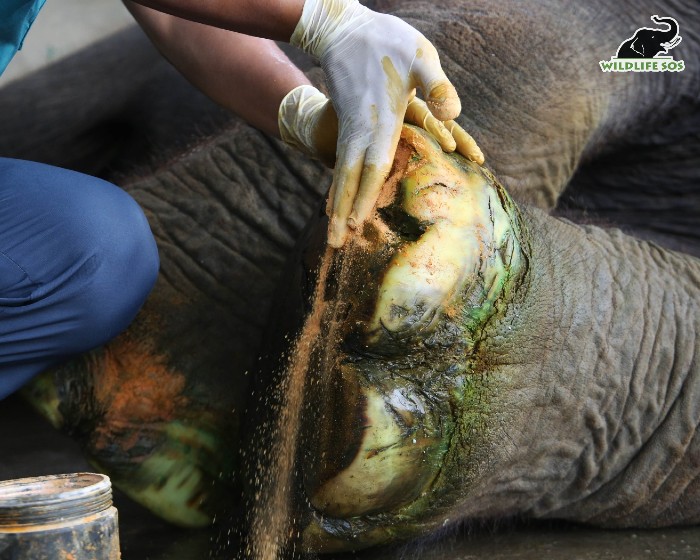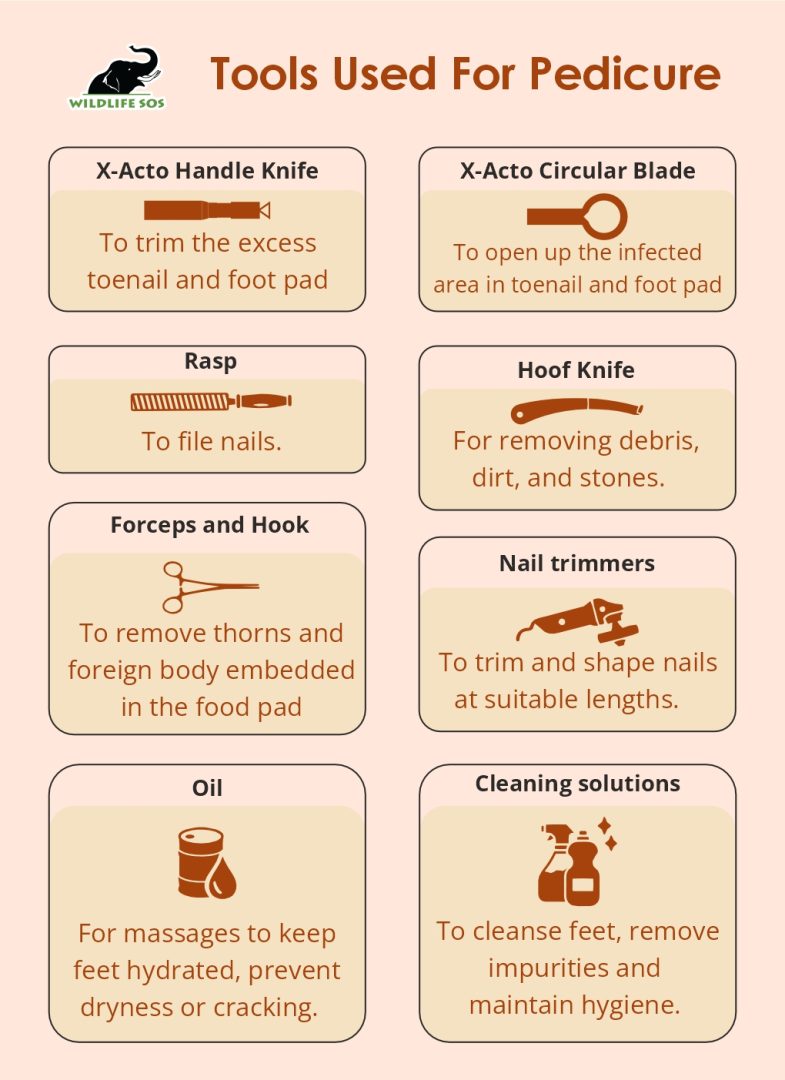Each part of the human body is equally vital for our overall well-being. Among them, our feet play a crucial role in providing us with stable balance and the ability to move around. Interestingly, in the case of elephants, their feet not only support them and their movement, but also serve as a means of hearing! That’s right! Low-frequency rumbles from over 30 kms away can be sensed by an elephant’s feet.
These gigantic mammals spend a major portion of their life standing or moving, which is why their feet are equipped with large, thick, and soft foot pads that evenly distribute the pressure on each foot. Predigits, which are enlarged false toes attached on their fat foot pads, help to move the load from the sole to the limb. However, for elephants under captivity, their feet, which serve as bodyguards for elephants, are made to traverse over unnatural surfaces for prolonged periods, causing severe damages to them. Less is known about how additional weight of saddles and forceful walks on harsh roads can cause critical damage to each foot of a captive quadruped.
Wildlife SOS has rescued elephants from horrible conditions that miserably impacted their foot pads. Ill treatment and neglect not only led to their gait being permanently affected, but also a decline in their overall health, creating a huge risk to their survival. Under long-term care at Elephant Conservation and Care Centre (ECCC) and the Elephant Hospital Campus (EHC), these elephants receive constant and focused medical attention to their foot health to ward off a variety of problems that could further affect their mobility and quality of life.
Foot Problems in Elephants
Saved from street begging, the industries of wedding and tourism, and as circus elephants, these large mammals were not only found with terrible wounds across their body, but also with joint problems like ankylosis and osteoarthritis. Their foot pads, meant to be thick and supportive, have been gravely worn out, with some even having extremely thin soles. And that’s not all — constant wear and tear of their feet have left them prone to a range of chronic foot ailments that significantly impact their movement, and their daily life. Here are the prominent issues elephants rescued from distress are found with:
- Foot Infections: Fungal or bacterial infections in the feet that result in pain, swelling, and discomfort for an elephant.
- Abscesses: These are pockets of pus that develop in the foot’s tissues as a result of an injury or infection. Abscesses can cause anguish to elephants. Toenail abscesses require draining and urgent treatment by veterinarians.
- Foot Rot: Foot rot, like foot infections, is a condition where the foot’s tissues deteriorate and decay due to bacterial or fungal infections. Severe discomfort and lameness may result from it.

- Overgrown Nails: If elephants’ nails are neglected, they may grow too long, which can make it difficult for them to walk, and perhaps cause other foot issues.
- Foot Pad Injuries: The pads on the bottom of an elephant’s foot are found with injuries such as cuts, bruises, or abrasions, which can be painful and prone to infection.
- Arthritis: Just like humans, elephants can develop arthritis in their joints, which affect their feet. They experience stiffness, swellings, and extreme difficulty in their movement.
- Cracked Foot Pads: The foot pads of elephants are seen having cracks, particularly if they had been subjected to rough or abrasive terrain. Cracked pads can not only be hurtful, they can even increase the risk of infection.
At Wildlife SOS, expert veterinarians provide consistent medical aid for the health of elephants’ foot. While each issue is specifically addressed and treated, regular and tender foot care is a mandatory inclusion in their routine.
It Starts with Foot Observation
Foot observation marks the first step in caring for their feet. As part of their daily schedule, caregivers at our centres inspect the feet of elephants for indications of infection or injuries and monitor the healing of erstwhile ailments. This examination assists in pinpointing any potential issue that would require additional care.
In the wild, elephants walk for around 18-20 hours, which naturally trim their nails due to the varied terrain. In our rehabilitation efforts, we prioritise stimulating their natural behaviour by encouraging the elephants to walk on grasslands in and around their enclosure, lengths and duration of which are determined by their health situation. After each walk, our team meticulously probes the elephants’ footpad for any debris or substances that may cause them harm.
… Followed by Regular Pedicure
Foot cleaning of elephants is done to remove dirt, debris, and hazardous substances that accumulate in the sole’s crevices. Doing so also allows for a more thorough examination of the foot for early detection of any injury or infection. Furthermore, nail filing is necessary to keep the nails at the right length and prevent overgrowth, which can cause discomfort and infections. After this pedicure, the caregivers examine the elephants’ walking style, activity level, and behaviour once again to make note of any abnormality.

One Toenail Each Day
On average, an elephant’s toenail grows by 0.5 cm each month. A healthy toenail should not touch the ground; it should remain half an inch above it. If toenails elongate to meet the floor, pressure builds up in the cuticle, which could cause water accumulation, resulting in the cuticle to burst.
To maintain the desired care, caregivers at our centre diligently file toenails of pachyderms using the strategy of taking up one toenail of one elephant each day. The front feet of an Asian elephant have five toenails, whereas the back feet have four. It therefore takes 18 days to trim 18 toenails of each gentle giant, while also ensuring routine inspection of their feet.
Medicated Foot Baths, Laser Therapy & Hydrotherapy
We administer a medicated foot bath to elephants suffering from toenail abscesses. Natural remedies such as Epsom salt (magnesium sulphate crystals) and turmeric powder are mixed within lukewarm water that the elephant steps into. The immersion of feet lasts for about 20 minutes, and helps alleviate pain to a great extent. This routine treatment is often prescribed for up to six months (depending on the wounds), and effectively decontaminates the affected area.
Following the foot bath, the team dries the pad, and a dry application of the items mentioned above is spread over the targeted area. Magnesium sulphate helps in drying the tender tissue, killing bacteria, and reducing swelling and pain, while turmeric acts as a natural antiseptic.
After medicated foot baths, laser therapy is occasionally provided to elephants after chronic, infected abscesses on foot pads subside. Laser therapy sessions prescribed for elephants lessen their joint pain, repair damaged limb tissues, and relax the muscles of elephants as well.
Hydrotherapy offers guaranteed assistance to elephants who have endured strain on their feet. At the jumbo hydrotherapy pool at the Elephant Hospital Campus, the elephants experience the buoyancy of water, which helps them take the weight off their feet and relieves them from body aches.
Our dedicated teams are committed to protect and preserve the precious biological structures that support the massive mammals under our care. Apart from medical treatments and examinations, they make sure that sharp stones and elements that could cause any harm are removed from their fields to safeguard them from injuries or discomfort. As we continue to include foot care as a significant part of an elephant’s all-round upkeep, we urge you to come forward and make a donation and join our family of wildlife warriors.





